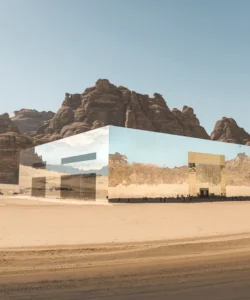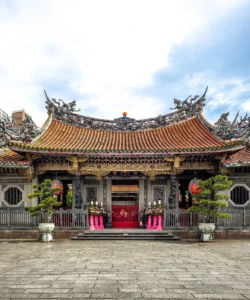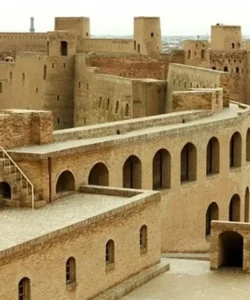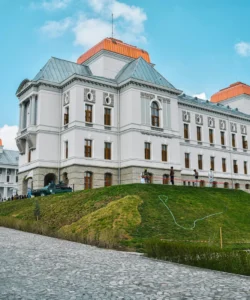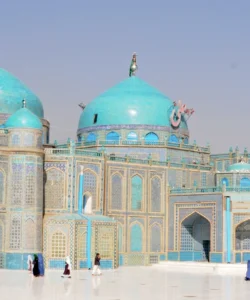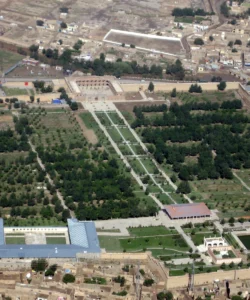The National Museum of Riyadh, officially known as the National Museum of Saudi Arabia, is a key cultural institution in the heart of the Kingdom’s capital city. It offers an immersive and comprehensive journey through the rich history, culture, and heritage of the Arabian Peninsula, from prehistoric times to the modern Saudi state.
Name: The National Museum of Riyadh (Arabic: المتحف الوطني, al-Mutḥaf al-Waṭanī; also The National Museum of Saudi Arabia)
Address: King Abdul Aziz Historical Center, Al Murabba, Riyadh 12631, Saudi Arabia. It is located within the larger King Abdulaziz Historical Center, a significant cultural and historical hub that also includes the Murabba Palace.
How to Get There:
The National Museum of Riyadh is centrally located and well-connected within the city.
- By Air: The closest international airport is King Khalid International Airport (RUH) in Riyadh. From the airport, a taxi or ride-sharing service (e.g., Uber, Careem) is the most convenient option, with a journey time of approximately 30-45 minutes depending on traffic.
- By Metro: Riyadh’s new public transport system, including the Metro, has made access easier. The museum is located near the National Museum Metro Station, which serves the Blue and Green Lines.
- By Bus: Several bus lines stop near the museum, providing a budget-friendly option.
- By Car/Taxi: Taxis and ride-sharing services are readily available throughout Riyadh for direct transfers. The museum has parking available on-site for those driving.
- By Foot: If you are staying in the city center, it is a pleasant walk, especially during the cooler months.
- Entrance Fee: The entry fee is typically nominal. Some sources note that entry may be free on certain days or for students and children.
- Closed Day: The museum is generally closed on Sundays. Its hours vary on other days, so it’s best to check the official website or a reliable local source before your visit.
Landscape and Architecture:
The National Museum of Riyadh is an architectural masterpiece that beautifully blends modern design with traditional Saudi and Islamic aesthetics, and it is integrated into a larger historical and naturalistic landscape.
- Architectural Design: Designed by renowned Canadian architect Raymond Moriyama, the museum’s architecture was inspired by the beautiful oases and the “Red Sands” of the Riyadh region. Its design won an international competition.
- Desert-Inspired Form: The building’s external envelope is designed to replicate Saudi Arabia’s mountainous regions, with a unique double-skin façade. The external concrete panels represent the mountains, while the internal blue panels seen through them represent the sky.
- Landscaped Gardens and Water Features: The museum is the centerpiece of the King Abdulaziz Historical Center, a large complex with beautifully landscaped gardens, fountains, and parks. These green spaces provide a serene environment and offer a space for relaxation and reflection.
- Modern and Innovative Exhibits: The interior of the museum features over 100,000 square feet of gallery space, using a blend of innovative and traditional exhibit technologies. The design of the exhibition halls is a journey through time, from the origins of the universe to the modern Saudi state.
- Symbolism: The design incorporates subtle cultural and religious motifs, such as color-coded metal cubes that evoke the shape of the Kaaba, guiding visitors through the various galleries in a symbolic manner.
- Integration with Murabba Palace: The museum is strategically located near the Murabba Palace, the former royal residence of King Abdulaziz, which is now one of the city’s major museums. This integration creates a comprehensive historical experience.
What Makes It Famous:
- Comprehensive History of Saudi Arabia: The National Museum is renowned for its immersive journey through the entire history of the Arabian Peninsula and the Kingdom of Saudi Arabia. Its eight main exhibition halls cover a vast timeline from the prehistoric era, through ancient Arabian kingdoms, the rise of Islam, and the unification of the modern Saudi state.
- Custodian of National Heritage: It is the primary custodian of Saudi Arabia’s national heritage and culture, housing a unique collection of artifacts, ancient scripts, rare books, and coins that tell the story of the nation’s evolution.
- Innovative Exhibitions: The museum is celebrated for its use of innovative resources, including stunning dioramas, interactive displays, and multimedia presentations that bring history to life for visitors of all ages.
- Architectural Masterpiece: The building itself is an architectural marvel, with a design that pays tribute to the natural landscape of Saudi Arabia, blending modern aesthetics with cultural symbolism.
- Cultural and Educational Hub: It serves as a vital hub for cultural exchange and education, hosting temporary exhibitions, educational programs, and workshops that promote a deeper understanding of Saudi heritage.
- Models of Holy Sites: A key highlight for many visitors is the hall dedicated to the Hajj and the Two Holy Mosques, which features large-scale replicas of both Al-Masjid Al-Haram in Mecca and Al-Masjid an-Nabawi in Medina, showcasing their evolution over time.
Differences from Some Other Wonders:
- Museum as Primary Wonder: Unlike natural wonders (like Al Wahba Crater or the Edge of the World) or ancient archaeological sites (like Hegra and AlUla Old Town), the National Museum’s “wonder” is entirely man-made and educational. Its primary purpose is to preserve and interpret history through a curated collection.
- Contemporary Architecture with Thematic Relevance: While historical monuments like the Red Fort or the Taj Mahal are famous for their ancient styles, the National Museum’s fame is rooted in its modern, prize-winning architecture that is conceptually inspired by the desert landscape and the Kaaba, demonstrating a different kind of artistic and design genius.
- Comprehensive National Narrative: While other museums may focus on specific aspects of history (e.g., the Malay Technology Museum), the National Museum of Riyadh provides a broad and comprehensive narrative of the entire history of Saudi Arabia, from the natural universe to the modern unification of the country. This national-scale storytelling is its core function.
- Integrated into a Historical Center: Its location within the King Abdulaziz Historical Center, alongside Murabba Palace and other institutions, makes it a part of a larger historical and cultural precinct, rather than a standalone attraction.
- Focus on Preservation and Education: The museum’s mandate is to preserve artifacts and educate the public, providing an intellectual and cultural experience that differs from the adventure-based thrills of Jerudong Park or the natural majesty of the Himalayas.
The National Museum of Riyadh Photos:





































